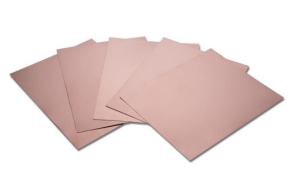Technological Landscape and Market Transformation in PCB FR-4 Material Industry
From Foundational Materials to Strategic Resources: Technological Leaps and Industrial Restructuring
I. Technological Evolution Pathways in Industry Development
1. Four Generations of Resin System Innovations
①First Generation (1980s): Dominated by bisphenol-A epoxy resin, Tg=130°C (DSC method), Dk=4.8@1MHz.
②Second Generation (2000s): Introduction of phenolic curing agents, Tg increased to 150-170°C, CAF (conductive anodic filament) resistance improved to 10⁹Ω.
③Third Generation (2015s): Halogen-free flame retardant systems (phosphorus-nitrogen synergy), bromine content <900ppm (IEC 61249-2-21).
④Fourth Generation (2020s): High heat-resistant/high-frequency modified resins (PTFE/ceramic composites), Dk=3.8±0.05@28GHz.
2. Breakthroughs in Reinforcement Materials
①Glass Fiber Cloth: Transition from traditional E-glass (SiO₂ 54%) to low-Dk NE-glass (SiO₂ 60% + B₂O₃ 10%), reducing Dk by 12%.
②Thickness Control: Mass production of ultra-thin glass cloth (13μm) enabling 0.2mm ultra-thin FR-4 substrates (JIS C6481 standard).
3. Advancements in Copper Foil Technology
①Surface Roughness Optimization: HVLP (Hyper Very Low Profile) copper foil roughness reduced from Rz=5μm to 1.5μm, lowering insertion loss by 20%@10GHz.
②Oxidation Resistance: ENEPIG (Electroless Nickel Electroless Palladium Immersion Gold) process extends solderability lifespan >12 months (IPC J-STD-003C).
II. Global Market Landscape and Competitive Dynamics
1. Production Capacity Distribution (2023 Data)
Region | Market Share | Key Players | Technological Advantages |
China | 58% | Shengyi Tech, Wazam New Materials | High-frequency substrates (5GBase station) |
Japan | 22% | Panasonic, Hitachi Chemical | High heat-resistant materials (automotive electronics) |
Europe/USA | 15% | Isola, Rogers | Aerospace-grade specialty FR-4 |
Others | 5% | Taiwan Union, Liantec | Consumer electronics substrates |
2. Key Technological Competition Focuses
①High-Frequency Materials: Dk/Df stability (±0.02 tolerance) as a competitive threshold for 5G mmWave.
②Environmental Compliance: EU RoHS 3.0 (2025) mandates total halogens <1500ppm, driving halogen-free upgrades.
③Cost Control: Nanofiller dispersion technology reduces ceramic content from 40wt% to 25wt%, cutting costs by 18%.
III. Green Manufacturing and Circular Economy Transition
1. Industrialization of Bio-Based Epoxy Resins
①30% castor oil derivatives replace petroleum-based epoxy resins, reducing carbon footprint by 32% (LCA analysis, ISO 14040).
②DuPont EC-8700 series certified by UL ECOLOGO, adopted in Apple’s supply chain.
2. Waste Recycling Technologies
①Microwave Pyrolysis: FR-4 waste processed in 2.45GHz microwave fields achieves >90% glass fiber recovery and >95% copper recovery.
②Chemical Depolymerization: Supercritical CO₂ separates epoxy resin (85% recovery), residues <5% (EU ELV Directive).
3. Energy-Saving Processes
①Low-temperature lamination (150°C vs. traditional 180°C) reduces energy consumption by 25% (IPC-4552A).
②Water-based ink printing replaces solvent-based processes, cutting VOC emissions by 80% (EPA Method 24).
IV. Industry Challenges and Countermeasures
1. Technical Bottlenecks
Balancing High Frequency and Heat Resistance: Materials with Dk<4.0 typically have Tg<160°C, while Huawei’s 5G Base station PCB Whitepaper demands Dk=3.8 and Tg≥180°C.
Solution: Develop biphenyl epoxy/cyanate ester blends (Hitachi MCL-E-679F: Tg=210°C, Dk=3.9@10GHz).
2. Supply Chain Risks
80% of electronic-grade glass fiber production concentrated in China (Jushi Group, Chongqing Polycomp), geopolitical factors caused 23% price volatility in 2022.
Alternative: Aramid fiber-reinforced substrates (DuPont Kevlar®/epoxy, CTE=6ppm/℃).
3. Standardization Pressures
IPC-4101E (2023) introduces ±5μm tolerance for 82μm ultra-thin specs, reducing yield from 85% to 70%.
Countermeasure: AI visual inspection (AOI + deep learning) boosts defect detection to 99.5% (Keyence case study).
V. Decadal Technology Trends Forecast
1. Material Innovation Directions
①Molecular-Level Design: DFT (Density Functional Theory) optimizes resin polarity, targeting Dk=3.5@100GHz.
②Smart Substrates: Embedded capacitors/inductors (ZBC® technology) with nano-Fe₃O₄ particles in dielectric layers, capacitance density >50nF/cm².
2. Manufacturing Paradigm Shifts
①Continuous Lamination: Roll-to-roll production reduces substrate costs by 30% (Schmid Group trial data).
②3D-Printed FR-4 : Covestro’s UV-cured epoxy achieves interlayer bond strength >30MPa (ASTM D1002).
3. Emerging Application Drivers
①6G Communications: Terahertz (0.3THz) demands spur ultra-low-loss FR-4 (Df<0.002).
②Space Electronics: Radiation-resistant FR-4 (TID>100krad) market grows 15% annually (ESA forecast).
VI. Breakthrough Strategies for Chinese Enterprises
1. Technological Case Studies
①Shengyi Tech S7432: High - Frequency FR-4 (Dk=3.8±0.05) breaks Rogers’ monopoly, enters Ericsson’s supply chain.
②Wazam New Materials H5: Carbon-hydrogen modified resin achieves Df=0.005@77GHz, adopted by NIO.
2. Industrial Chain Collaboration
Copper Foil-Resin-Glass Fiber Alliance: CATL (copper foil) + Wanhua Chemical (epoxy) + Jushi Group (glass fiber) co-develop automotive-grade FR-4.
3. Standardization Leadership
Leading the formulation of GB/T 4723-202X Halogen-Free Copper Clad Laminate national standard, setting Br/Cl limits <800ppm (stricter than IEC).
Data Sources & Verification:
Market Data: Prismark 2023 Q2 Report, China Electronic Materials Industry Association
Technical Standards: IPC-4101E (2023), IEC 61249-2-21 (2021)
Testing Methods: Dielectric properties per IPC TM-650 2.5.5.13; thermal reliability per JEDEC JESD22-A110
FR-4 Laminate: Definition, Core Properties, and Engineering Application Guide
The Diverse Application Map of FR-4 Laminates From Consumer Electronics to Aerospace
Author:Jack Wang

